Cranmer Bible Paper
CRANMER BIBLE
PHILANTHROPIC LODGE No. 304
THE LODGE CRANMER BIBLE
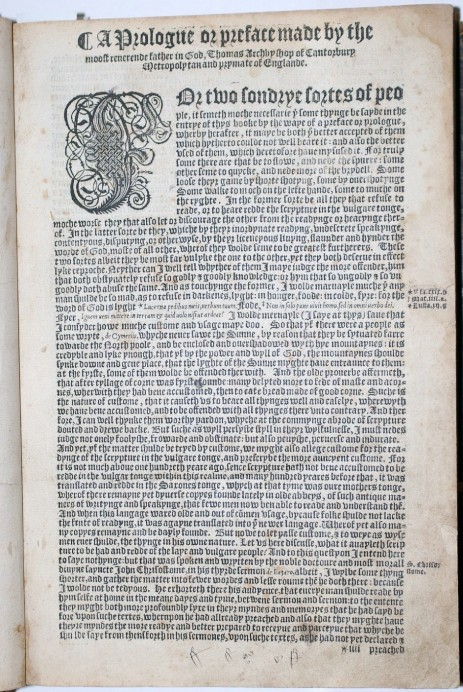
Cranmer Prologue Page 1
A Presentation to the Lodge and its Visitors of the research undertaken by
Mr Ed Potten.
The Allerton, Leeds. 26th Sept. 2018
‘IN MY DEFENS GOD ME DEFEND AND BRING MY SAULLE TO ANE GUID END’
PHILANTHROPIC LODGE No. 304’S GREAT BIBLE
The history of book production is scattered with the names of a select few books which have entered into folklore. Amongst the millions of books printed in the first five hundred years of the press, these few are instantly recognisable by name alone:
The Gutenberg Bible
The First Folio of Shakespeare
The Canterbury Tales
Audubon’s Birds of America
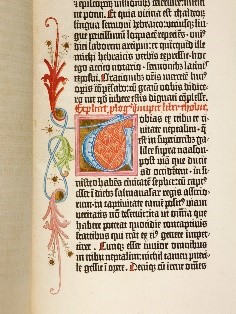
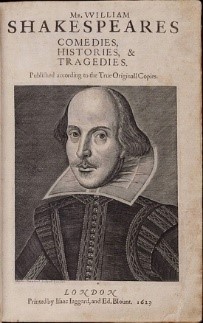
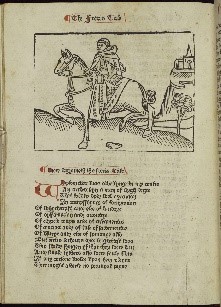
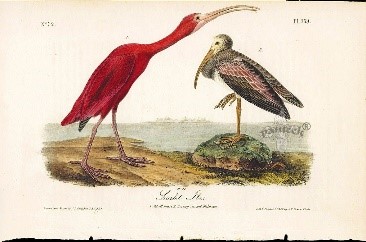
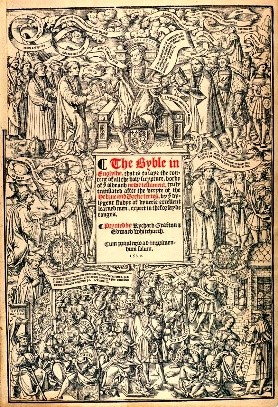
This paper focuses on the provenance and history of one copy of the Great Bible, exploring how it made its way to Philanthropic Lodge number 304, but it will range somewhat wider. It is hard to understand the importance of the Great Bible without first understanding something of its history, and the painful struggle undertaken by generations of men who sought to bring the word of God to the common man, so it begins with a brief overview of the key moments in the history of the Bible in England.¹
Creed and the Lord’s Prayer in Anglo Saxon.
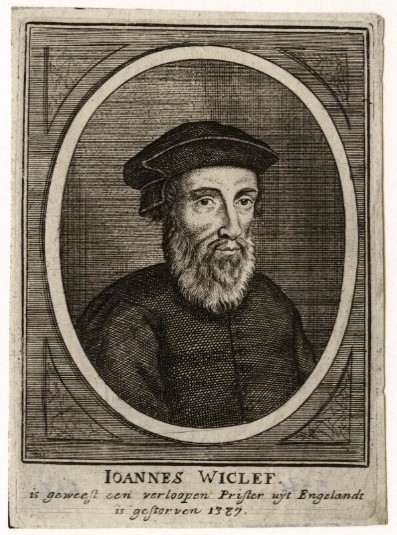
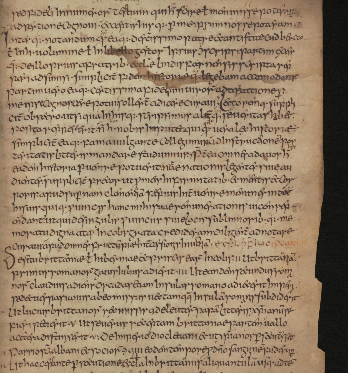
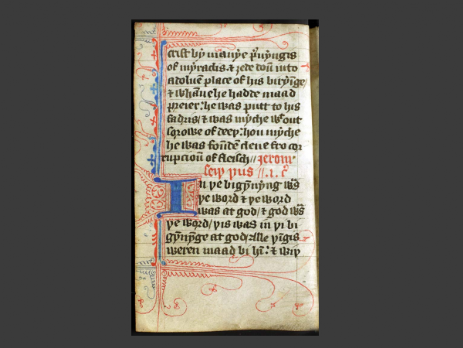
From the outset, the English clergy openly opposed Wyclif’s teachings. His teachings on the Eucharist were declared heresy in 1382, Wyclifite Testaments were condemned by Archbishop Arundel in 1407, translating the Bible into English was forbidden under the 1408 Constitutions of Oxford, and Wyclif's followers, who came to be known as Lollards, were suppressed, often on pain of death. This suppression stifled the translation of the Bible in England.
Across the Channel, however, things were moving apace. Following the fall of Constantinople in 1453 exiled Greek scholars fled across Europe, bringing with them both their learning and their libraries of manuscripts. In Italy they found a particularly receptive audience amongst the humanists. A new generation of Renaissance scholars were keen to make new translations of Greek and Hebrew manuscripts of the Old and New Testaments.
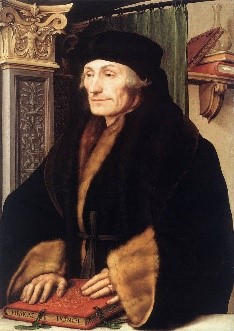
The influence of humanism was broadly felt in England. The English theologian John Colet (1467-1519), dean of St Paul's and founder of St Paul's School, travelled in Italy and caught the humanist bug. Colet began to lecture in Oxford, basing the lectures on readings of the New Testament in Greek. ³ It is possible that there he lectured to William Tyndale.
William Tyndale
John Colet
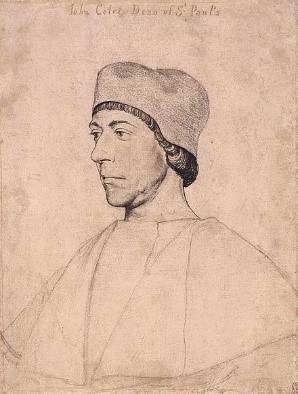
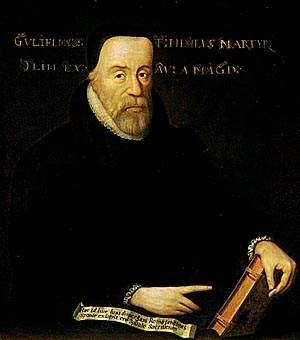
Tyndale was a Hebrew scholar, appalled by the fact that his Oxford theology degree syllabus did not include the study of scripture. He almost certainly acquired a copy of the Erasmus New Testament which proved the inspiration for his own translation. In an argument with a cleric he is memorably said to have uttered the famous words: “If God spare my life, ere many years I will cause a boy that driveth the plough to know more of the Scripture than thou doest” ⁴
Translating the Bible into English had been illegal since 1408 and was still so when Tyndale began work on his translation. After failing to find a safe place to work in London, he fled to Hamburg in 1524, then to Cologne, where a partial run of his testament was printed, before being suppressed by the Cologne authorities. A single fragment survives at the British Library. ⁵
Tyndale fled again, to Worms where, at last, in 1526 the Tyndale New Testament was finally published, the first printed edition of the English Bible. Copies were immediately smuggled into England, where they were ruthlessly sought out and burnt; only three copies of the 3000 survive, that at the British Library acquired in 1994 for just over 1 million pounds. They described it then as “the most important printed book in the English language”, and indeed it is Tyndale’s text which forms the basis of the Bible we know today. Many of its quirkier phrases have entered into common usage. ⁶
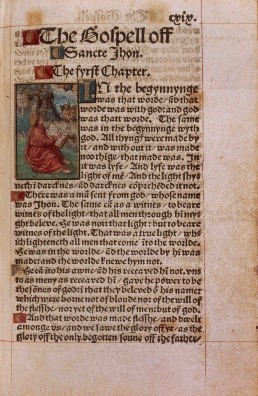
The translation of the Old Testament was as problematic and dangerous as that of the New. In 1527 Tyndale fled to Marburg, where the first five books translated from the Hebrew were issued in 1530. He continued to work on the translation in Antwerp, where he lived openly, but was arrested there in 1535, tricked by a spy of Henry VIII. He was tried for heresy and strangled then burned at the stake the following year, paying the highest of prices for his commitment to the production of the English Bible. His last words are said to have been “Lord, open the eyes of the King of England!”
Tyndale is rightly lauded as the first man to print a portion of the Bible in English, but it his contemporary Miles Coverdale, who holds the honour of printing the first complete English Bible.⁷ A priest, with strong views on Church reform, Coverdale, like Tyndale, was forced into exile, indeed it seems likely that he and Tyndale were acquainted in Antwerp, and he may have worked on Tyndale’s Testament. Tyndale’s work was certainly the basis of Coverdale’s own translation, executed in Antwerp in 1534 and published in 1536.⁸
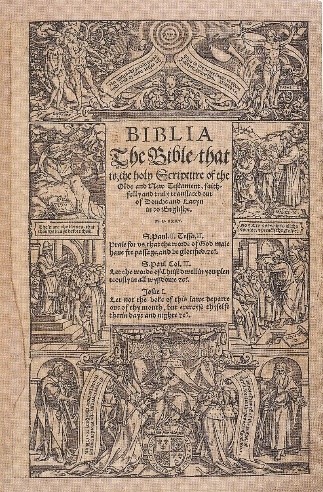
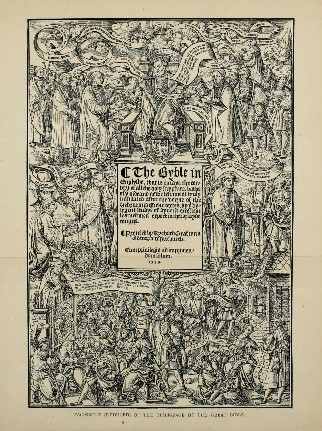
This ‘Great Bible’ appeared in 1539, with a second edition in 1540 containing Cranmer’s celebrated preface, the classic statement of the Reformation principle of ‘Scripture alone’. No fewer than 11 different editions and states of the Bible are recorded currently on the English Short Title Catalogue,¹⁰ issued between 1539 and the end of 1541, when publication was suspended, and it is likely many more variant states exist.¹¹ It drew its name, the Great Bible, from the King’s injunctions of 6 May 1541, which ordered that ‘the Byble of the largest and greatest volume, to be had in every churche’.
The Great Bible 1539
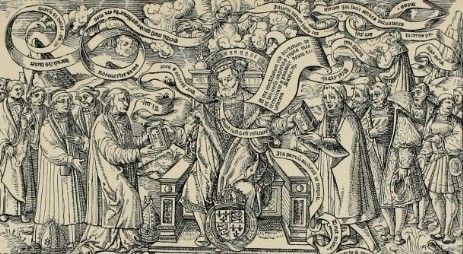
Despite Christ being the uppermost figure, it is the figure of Henry which dominates, the King portrayed as “a latter-day Moses”. ¹³ He is seated on his throne flanked with the royal arms and motto. He physically hands the word of God (Verbum Dei) to the bishops and clergy on his right hand, and to his chief minister Thomas Cromwell and others on his left. The bishops he instructs: “These things command and teach” (1 Tim. iv. 11), whilst Cromwell is admonished to “Judge righteously ... ye shall hear the small as well as the great” (Deut. i. 16, 17).
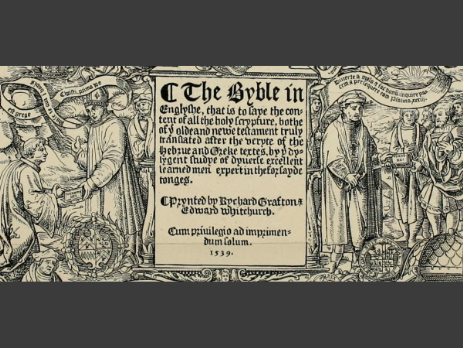
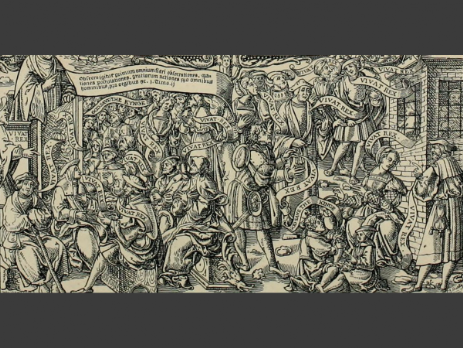
The Great Bible is a bibliographer’s nightmare. It was a complicated book from the outset, with multiple editions and states issued in a very short space of time. The sheets of all these imprints are frequently found muddled in individual copies; the printer or contemporary booksellers and book binders pulled together sheets from all and any edition to make a complete copy.
Additional muddle has been added by later generations of readers and collectors. The Great Bible is a book which saw heavy use and consequent damage. It has always been a book for display. Intended as an altar Bible, it was on view and heavily used in Church. In the eighteenth century, a later generation identified it as a collectable, the first authorized Bible of the English Church, and it took on a different display purpose. In both settings the portions most used for display - the title page and opening quires - had a tendency to become worn, damaged or lost entirely. Many copies of the Great Bible have been wholly lost, others survive in fragments, and most are in poor condition, wanting leaves.
As the book’s fame increased, so did its value. To the eighteenth- and nineteenth-century collector, a Great Bible missing the iconic title page was significantly less appealing than one complete. Enterprising booksellers soon caught on that a complete copy commanded a significantly higher price, and a healthy trade began in “perfecting’ imperfect copies. Booksellers would take three or four incomplete copies of the various editions of the Great Bible and from them form one complete copy, worth on the market three or four times the value of the fragments. Up until very recently a number of reputable book sellers had stock sheets of the Great Bible held in reserve, specifically for the supply of missing leaves. This has added a significant layer of complication to an already complicated picture.
The copy of the Great Bible which ended up in Philanthropic Lodge 304 is the perfect example of all these phenomena in play. It is a cut-and-paste of several different issues and variants, and unpicking its bibliographical history is challenging.
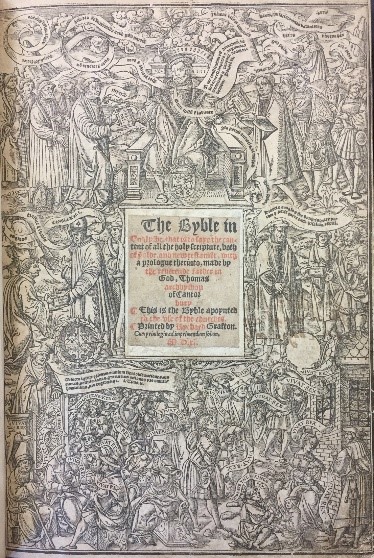
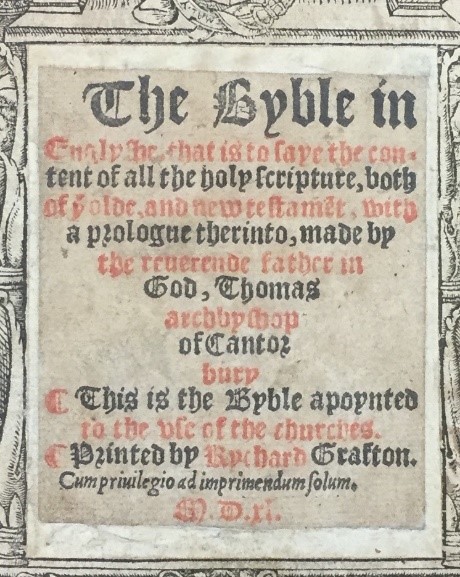
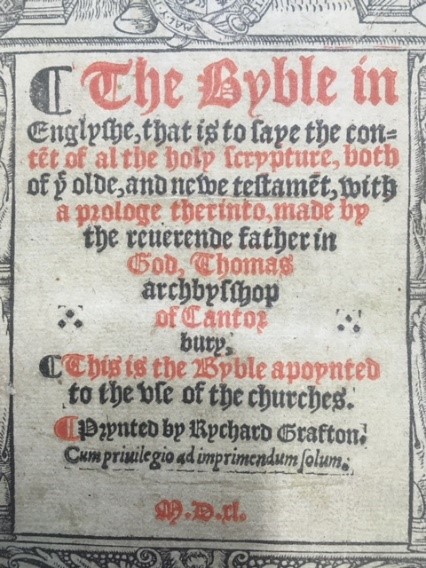
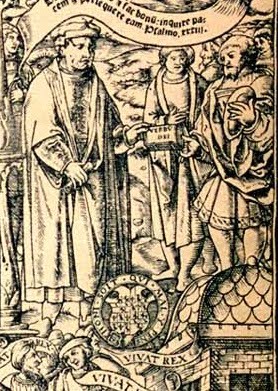
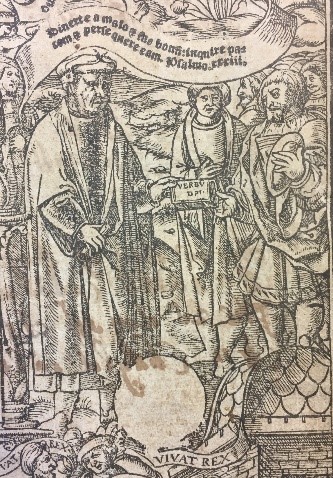
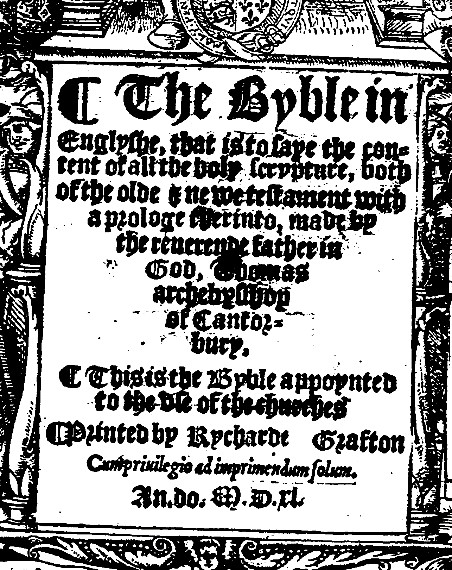
The Lodge Bible
The central panel, however, is more difficult to pin down. Only two editions are known (above) which are dated 1540 and which bear Richard Grafton’s name, ¹⁶ and neither matches the setting of the Lodge copy. There are many textual variations between the letterpress title pages, the key features summarised below.
| STC 2076 | Lodge copy | STC 2071 |
| Pilcrow | [Wanting pilcrow] | Pilcrow |
| Alternating red and black lines beginning with red. | Alternating red and black lines beginning with black. | Alternating red and black lines beginning with red. |
| con=tét of al the holy scrypture | con=tent of all the holy scripture | con=tent of all the holy scrypture |
| of yᵉ olde,and newe testame[n]t, | of yᵉ olde,and new testame[n]t, | of the olde & new testament, |
| prologe | prologue | prologe |
| archbysshop | archbyshop | archbysshop |
| [three dots to either side of line] | [no dots] | [no dots] |
| Cantor | Cantor | Cantor= |
| bury, | bury | bury, |
| apoynted | apoynted | appoynted |
| churches. | churches. | churches |
| Prynted by Rychard Grafton. | Printed by Rychard Grafton. | Printed by Rycharde [additional spaces] Grafton |
| [Variant page spacing of ‘Cum priuilegio’] | ||
| M.D.xl. | M.D.xl. | An. Do. M.D.xl. |
Despite these variations in title pages, frequently the last things to be printed with the preliminary quires, one might expect the text of the sixth Great Bible to be consistent across copies, but this is not the case. The printing of the Bible was not done as we might imagine today. Printing was a commercial activity and from the outset printers were always acutely aware of the delicate balance between income on expenditure. Despite John Tate’s foundation of the first English paper mill in around 1495, the majority of paper used in English printing was still imported in the first quarter of the sixteenth century and was an expensive commodity not to be wasted. The Great Bible was printed on multiple presses, but each followed the same process: a forme of type was composed and set representing two folio pages. These were inked and sufficient impressions were taken from them to satisfy the expected market. The type was then washed and dispersed back to the compositor’s tray, to be used to build up other pages and other formes.
As a consequence of this process, and the expense of paper and press work, there was no ‘proof’ stage to the process. As the impressions of particular sheets came off the press they were checked for errors. If a mistake was identified the press was stopped, a correction was made, and the press was then restarted.


The comparison of the Lodge Bible with other copies of the sixth Great Bible rapidly demonstrates just how common these variations between copies are.
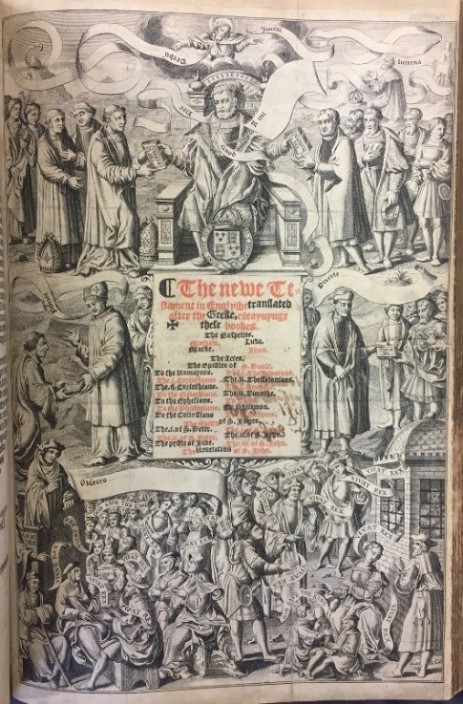
Turning to the title page of the New
Testament, things get more complicated still. The central panel of the title
page of the New Testament comes from the same edition as the bulk of the text
- the sixth Great Bible, issued in November 1541 - but as with the general
title page there is a printing variation between the Lodge copy and others of
this issue.¹⁷
(see below)
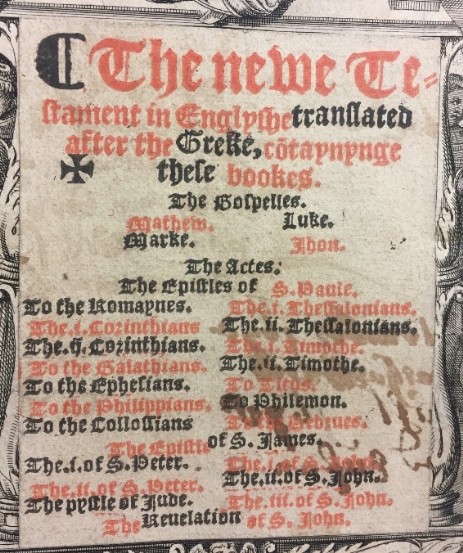
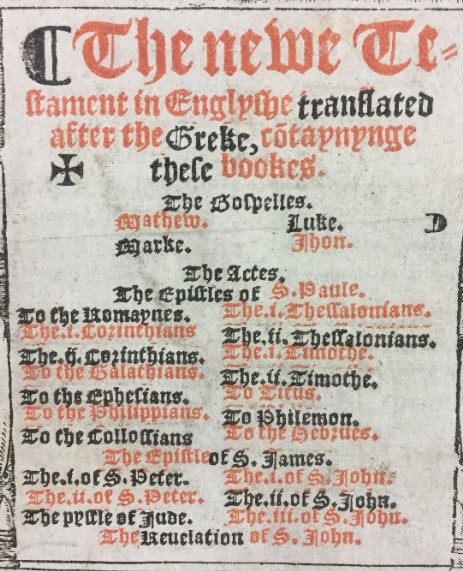
The Lodge Bible

The border though poses more
significant problems. At first glance, this appears to be a border engraved
on copper, rather than on wood, a copy, albeit imperfect, of the famous
woodcut discussed above. The obvious conclusion to draw would be that the
original woodcut border to the New Testament had at some point been damaged,
and during rebinding it was replaced with a copperplate border, re-used from
a later edition of the Bible. However, no later edition of the English Bible
has yet been identified which bears this engraved border. Is this a border
from a lost edition of the Bible? This seems highly unlikely. Copperplates
were expensive to produce and as a consequence tended to be re-used until
they were too worn, so one would expect to find it used not just in one
edition of the Bible, but over and over again in different editions. Is this
a copperplate produced for another purpose? Again, this seems unlikely - it
is clearly a title page border, based on the most iconic of all Bible title
pages, what other purpose could it have served? At the top edge there is the
appearance of a plate mark, and in the absence of other evidence one could
conclude that this is a copperplate created for an edition but unused. A
proof plate perhaps, in a partially completed state?
Could this apparently engraved title page not in fact be engraved at all, but instead be a well-executed pen and ink drawing? This is not as unlikely as it sounds. This paper has already hinted at the lucrative trade in loose leaves from iconic books which blossomed in the early nineteenth century, used to perfect damaged copies. This practice ran hand-in-glove with a companion trade in the production of facsimile leaves - startlingly well-executed pen and ink drawings of printed pages, used to supply missing leaves in expensive books. This was big business in the early nineteenth century and Bibles and Shakespeare folios were the principal victims. The best facsimile maker was John Harris (1791-1873), whose facsimiles of leaves from Caxton’s still deceive dealers and academics today. The greatest patron of facsimile leaves was the chocolate manufacturer and Bible collector Francis Fry (1803-1886), whose “enthusiasm for perfecting copies of incomplete bibles [...] unwittingly muddied the waters for future students of their printing history”.¹⁸ This example though is neither the work of Harris nor Fry - it is too early for either. If it is a facsimile leaf, it represents an intriguing and potentially early example of the perfection of a book in this way. It is interesting to note that this is not a careful copy designed to deceive, rather a well-done, but sketchy copy of the iconic woodcut. The scrolls in which the words of Christ and Henry should appear have been left largely blank. Proof plate or pen and ink drawing, the title page to the New Testament is an intriguing mystery.
The two
title pages from the Lodge Bible, however, have one more secret to reveal, one
which allows us finally to unpick their history.
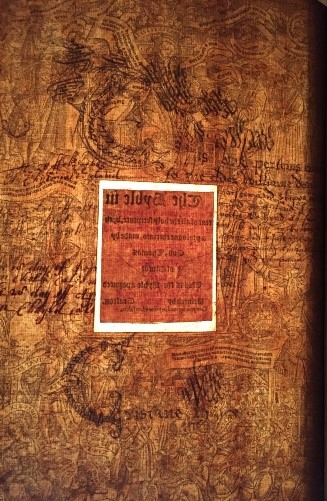
- Lodge Bible
When a bright light is shone through the title pages, something startling is revealed. The rear of the border of the opening title page is revealed to have once been covered with elaborate calligraphic annotations, now pasted over with a blank leaf, whilst the central panel bears no annotations.
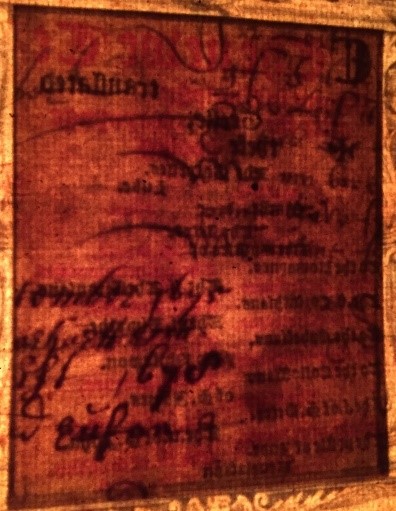
<Central Panel Rear
-New Testament
Panel ‘inserted’ back to
present title page, showing
alignment of hand writing>
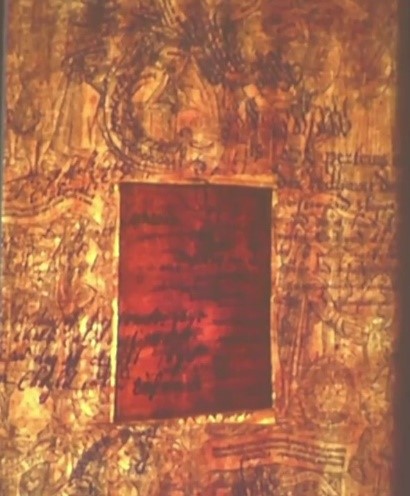
How do we
explain this oddity? Based on this evidence, we can begin to reconstruct the story:
in 1819 the Lodge sought to have a damaged copy of the Great Bible in their
possession repaired and rebound. At that point the famous opening wood cut title
page to the Bible was either so badly damaged as to be irretrievable, or more
likely missing, but the title page to the New Testament was not, although it
was heavily annotated on the back. So, in order to recreate the all-important
opening leaf, it was decided to cut out the border from the New Testament title
page and paste into its centre a central panel from an entirely different copy
of the Great Bible, presumably a badly- damaged leaf supplied by a bookseller
with a stock of loose pages. By chance, this stray central panel turned out to
be from an unrecognised edition, dated 1540 and bearing Grafton’s name in the
imprint.
This left
the Lodge with the excised centre of the New Testament title page floating
free, so, we must conclude, either an impression from a proof plate was
secured, or a pen and ink facsimilist was commissioned to produce a replica of
the border, into which the New Testament text was pasted.
This left
the Lodge with the excised centre of the New Testament title page floating
free, so, we must conclude, either an impression from a proof plate was
secured, or a pen and ink facsimilist was commissioned to produce a replica of
the border, into which the New Testament text was pasted.
The shadowy
impressions which underlie the old New Testament title page offer a fleeting
glimpse into the history of the Lodge copy. They reveal that the Bible in the
late seventeenth century was in the ownership of a Wyllyam or Williams family,
and that just as generations of Bible owners have done, they used a blank leaf
within the Bible to record family births, deaths and marriages. It is hard now
to decipher much, but the book appears to have belonged to one Charles Wyllyam
and his wife Christine, and the clearest entry records the birth on 28 February
1683 of a child called David. We know nothing more of this seventeenth-century
family, other than that to them the Bible was not a treasure, but instead a
working book and the focus of their family devotions.
The Wyllyams
family left a clear mark on their Bible, albeit one that future generations
sought hard to eradicate, but they are not the earliest owners of the book we
can trace. There are a number of indications within the text that the book’s
owner in the sixteenth century was a working priest. This was the Bible decreed
to be chained within every parish church, so a clerical ownership is perhaps
unsurprising. The owner of the Lodge copy left a variety of marks. Some are
indicative of his everyday use of the book. The title page to the second
portion of the Old Testament has been marked up with the folio numbers of the
openings of the various books of the Bible, a rapid way for the priest to
navigate his way through the text, and the text to Psalms 104 and 105 have been
annotated for morning prayer on the 20th and 21st day.¹⁹ Elsewhere in the book other early annotations have been
cropped during the rebinding, rendering them all butillegible.²⁰ An early annotator left
a series of pen trails in the book, one of which recorded his name: “Johnne
Logane mark my hand at the pen”.²¹
It was also John Logan
who penned the little couplet which gives this paper its title:
In my defens God me defend
and bring my saulle to ane guid end.
When did all the chopping and changing of title pages take place? To the best of our knowledge the Bible was gifted to the lodge by one ‘Brother Clarkson’ in 1801. On 28 December 1801, at the Festival of St. John, the Lodge gratefully acknowledged the donation by members of a variety of candle sticks, tools, boxes, chests, pillars and pedestals. Brother Clarkson is there credited with the donation of a “Bible’, a silver square and compasses. Although we cannot be certain that this Bible is the Great Bible, it seems a reasonable assumption.
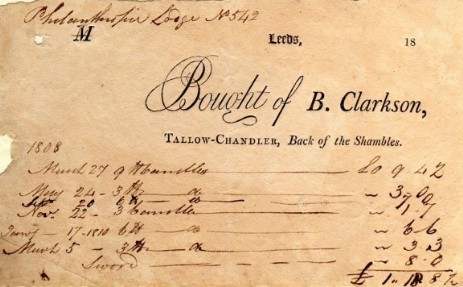
The binding of the Lodge Bible is remarkable. Redolent of the period, it is bound in full blue grained morocco and has been lavishly decorated in what is known as cathedral style, a style popular in England and France in the first half of the nineteenth century, whereby the covers were decorated with designs inspired by the architecture of a medieval cathedral. The binding is a superb piece of work, far superior to much of the output of the trade in the period, both in terms of its forwarding – the stitching and sewing, attachment of boards, etc. - and its finishing - the decoration.
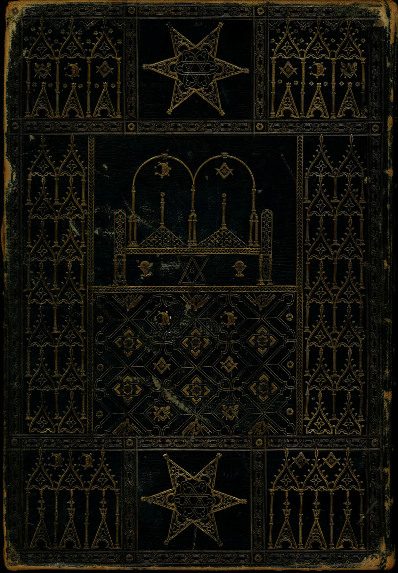
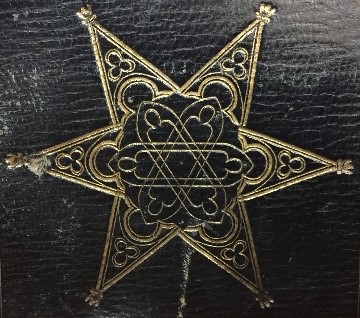
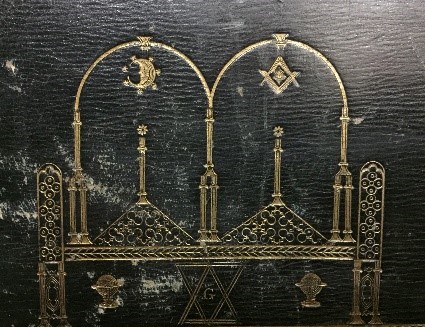
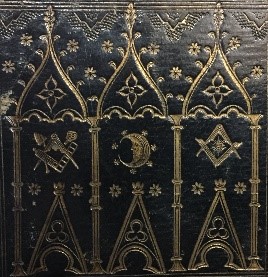
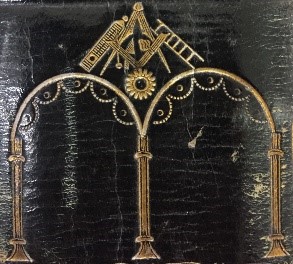
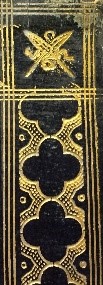
A search for Cathedral bindings finds many which are stylistically similar, but again, no specific matches, and none with a Masonic element. ²⁶ Does an exploration of where the binding might have been executed help?
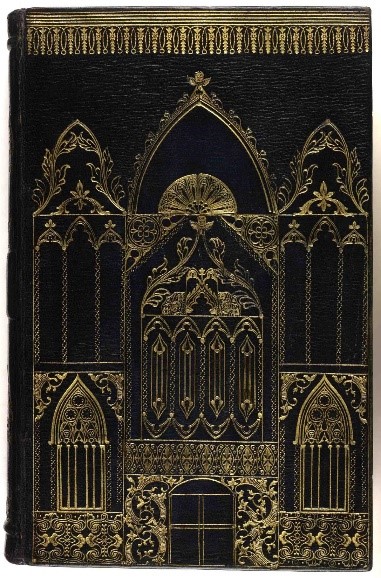
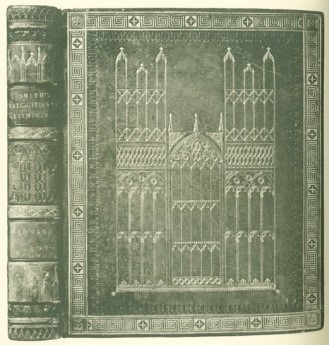
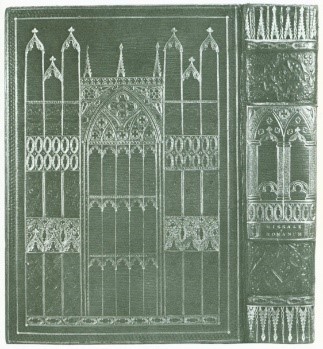
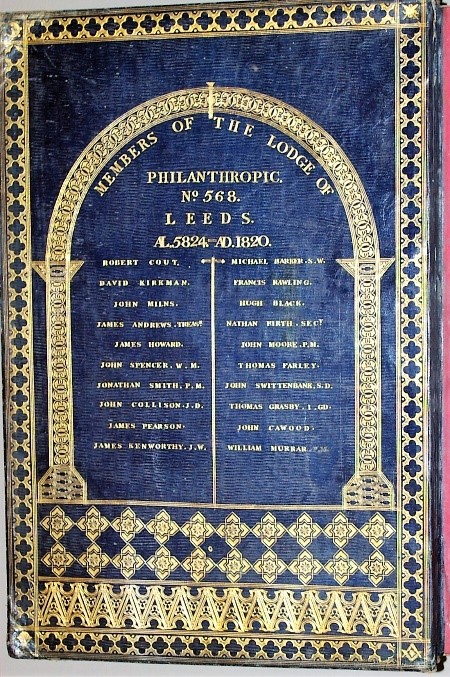
Philanthropic Lodge 304’s Great Bible is a powerful witness to nearly 500 years of history. From its early use as a working Bible in a church setting, where it presumably remained until usurped by the arrival of the King James Bible in 1611, it moved into private hands, becoming a focus of family devotion in the seventeenth century. In the late eighteenth century, it was in the hands of a chandler from Leeds, before moving back into institutional hands in 1801, gifted to its current owner, Philanthropic Lodge 304. Today it is on deposit in York Minster Library, where it can be more safely stored and more easily made available to scholars and the public.
Back Panel of the Lodge Bible
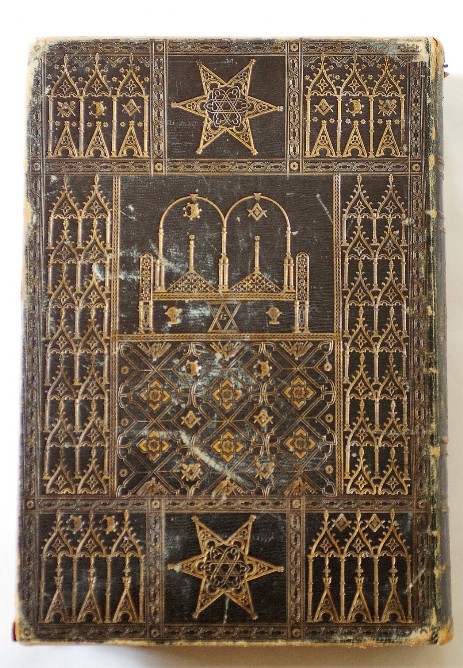
REFERENCES
¹What follows is drawn primarily from three sources: The John Rylands Library Manchester: Catalogue of an exhibition of manuscript and printed copies of the scriptures (Manchester: Manchester University Press, 1911), P. Arblaster, G. Juhész and G. Latré (eds.), Tyndale's Testament (Turnhout: Brepolis, 2002) and the Cambridge University Library online exhibition, Great and manifold blessings: The making of the King James Bible (http://www.lib.cam.ac.uk/exhibitions/KJV/ ) - last accessed 1 October, 2018.
² Anne Hudson and Anthony Kenny, ‘Wyclif [Wycliffe], John [called Doctor Evangelicus] (d.1384)', in the Oxford Dictionary of National Biography (henceforth, ODNB).
³B. Trapp, ‘Colet, John (1467-1519), in ODNB.
⁴ David Daniell, “Tyndale, William (c.1494-1536)', ODNB.
⁵ Alfred W.Pollard and Gilbert R. Redgrave, A Short-title catalogue of books printed in England, Scotland, & Ireland and of English books printed abroad 1473-1640, (2nd ed.) (London: Bibliographical Society, 1991) [henceforth: STC (2nd ed.)], 2823; T. H. Darlow and H.F. Moule, Hstoriical catalogue of printed editions of the English Bible: 1525-1961,(revised by A.S.Herbert) (London New York, N.Y.: The British and Foreign Bible Society; The American Bible Society, 1968) [henceforth Darlow & Moule], 1; British Library shelfmark: BL G.12179.
⁶STC (2nd ed.), 2824; Darlow & Moule, 2. Copies at the British Library, St. Paul’s Cathedral and the Wurtembergische Landesbibliothek. See: https://www.bl.ul/collection- items/ william-tyndales-new-testament
⁷ David Daniell, ‘Coverdale, Miles (1488-1569)’ in ODNB.
⁸STC (2nd ed.), 2063 and STC (2nd ed.), 2063.3, both Darlow & Moule, 18.
⁹STC (2nd ed.), 2066, Darlow & Moule, 34.
¹⁰ http://estc.bl.uk.
¹¹WSTC (2nd ed.), 2068 ([Paris]: Prynted by [Francis Regnault, and in London by] Rychard Grafton [and] Edward Whitchurch. Cum priuilegio ad imprimendum solum, 1539 [April]); 2069 (Prynted at L[ondo]n: by [Thomas] Petyt, and [Robert] Redman, for Thomas Berthelet: prynter vnto the kyngis grace. Cum priuilegio ad imprimendum solum, 1540); 2070 ([London]: Prynted by Edward whytchurche cum priuilegio ad imprimendum solum, M.D.xI. [1540]); 2071 ([London]: Prynted by Rychard Grafton. Cum priuilegio ad imprimendum solum, M.D.x1. [1540]); 2072 ([London]: Printed by Edwarde Whitchurch [or Rycharde Grafton] Cum priuilegio ad imprimendum solum, 1541 [Nov.]); 2073 ([London]: Printed by Edwarde Whitchurch [or Rycharde Grafton] Cum priuilegio ad imprimendum solum, 1541); 2074 ([London]: Prynted by Edwarde Whitchurch cum priuilegio ad imprimendum solum. Finished the .xxviii. daye of Maye., Anno domini M.D.XLI. [1541]); 2075 ([London]: Printed by Edwarde Whitchurch. Cum priuilegio ad imprimendum solum, 1541); 2076 ([London]: Printed by Rycharde Grafton [or Edward Whitchurch] cum priuilegio ad imprimendum solum, An. do. M.D.xl. [1540, i.e. 1541]); see too ESTC 5124684 ([S.L]: Prynted by Edward Whitchurch. Cum priuilegio ad impri mendu[n] solum, 1539, not in STC) and ESTC S469551 (([London]: Printed by Edw. Withchurch cum priuilegio ad imprimendu solu, An. Do. M. D.xl. [1540], not in STC).
¹² See: W.F. Moulton, The history of the English Bible (London: Cassell, Petter and Galpin, 1878) pp- 138-9.
¹³ Ruth Samson Luborsky and Elizabeth Morley Ingram, A guide to English illustrated books, 1536-1603 (Tempe, Ariz.: Medieval & Renaissance Texts & Studies 1998), [henceforth: Luborsky & Ingram], p. 96.
¹⁴Howard Leithead, ‘Cromwell, Thomas, Earl of Essex (b. in or before 1485, d. 1540)’ in ODNB.
¹⁵STC (2nd ed.), 2075; Darlow & Moule, 62.
¹⁶ STC (2nd ed.), 2076; Darlow & Moule, 63; and STC (2nd ed.), 2071; Darlow & Moule, 54.
¹⁷ There is a pilcrow on other copies of the New Testament title page at the end of the line ‘Luke’ wanting from the Lodge copy.
¹⁸ David J. Hall, 'Fry, Francis (1803-1886)’, ODNB.
¹⁹ Sig, CClr.
²⁰ See, for example,sig, [14r.
²¹ Sig. [cross]3v.
²² Receipt held in the archive of Philanthropic Lodge 304, Brotherton Library: L.304.C150, ex inf. Peter Smith. See too Charles D. Harris The history of Philanthropic Lodge No. 304 1794-1994 [Leeds: 1994], p. [36].
²³ For Lovejoy see: British Booktrade Index http:/ /bbti.bodleian.ox.ac.uk/details/?traderid=43825, G.D. Hobson, English bindings, 1490-1940, in the library of |.R. Abbey (London: Chiswick Press, 1940), p. 146, Charles Ramsden, London bookbinders 1780-1840 (London: Batsford, 1956), plate XIX and Maggs Bros.,catalogue 1075, Bookbinding in the British Isles part II (London: Maggs Bros., 1987) numbers 260, 261.
²⁴ Ex inf. Philippa Marks, to whom the author is grateful for her advice and assistance in researching the bindings mentioned in this paper. Her forthcoming article, Selected English masonic bookbindings, will appear in the Electronic British Library Journal in Spring 2019 (http://www.bl.uk/eblj/index.html ).
²⁵ See,for example: https:/ /www.bl.uk/catalogues/bookbindings/ Largelmage.aspx?Record[d=020000018472&Imageld=Imageld=57110&Copyright=BL.
²⁶ See, for example: https://www.bl.uk/catalogues/bookbindings/Largelmage.aspx?Recordd=020000000672&Imageld=Imageld=39941&Copyright=BL ;
https://www.bl.uk/catalogues/bookbindings/Largelmage.aspx?Recordld=020000000850&Imageld=Imageld=40030&Copyright=BL;
https://www.bl.uk/catalogues/bookbindings/Largelmage.aspx?RecordId=020000001152&Imageld=Imageld=40181&Copyright=BL ;
https://www.bl.uk/catalogues/bookbindings/Largelmage.aspx?RecordId=020000001200&Imageld=Imageld=40205&Copyright=BL
²⁷Hobson & Robinson, John Heaton, John Dyson, Samuel Nicholson, Thomas Inchbold, William Webster.
²⁸ MaggsBros., catalogue 1212, Bookbinding in the British Isles: Sixteenth to the twentieth century (London: Maggs Bros., 1996), number 208.
²⁹ See: https: www.bridgemanimages.com/en-GB/asset/ 150579/ library-and-museum-of freemasonry/book-bound-by-freemason-william-lubbock-fl-1792-1822-red-moroccan-leather-and-gold
³⁰ Ex inf. Philippa Marks.
³¹ For Walther see British Booktrade Index, http:/ /bbti.bodleian.ox.ac.uk/details/ ?traderid=72796 ; Maggs Bros., catalogue 1075, numbers 228 and 229, Ramsden, London book binders, pp. 144-5.
³² The law advertiser for 1824 (London:]. W. Paget, 1824), vol. 2, p. 214 and London Gazette, number 18439 (Tuesday, February 5, 1828), p. 254.
³³ William Parson, General and commercial directory of the borough of Leeds, (Leeds: Edward Baines, 1826), p. 163 and listed in subsequent editions through to 1830; Pigot and co.'s national
Commercial directory for 1828-9 (London: Pigot and Co., [1829]), p. 1020.
³⁴ Edward Baines History, directory & gazeteer, of the County of York (Leeds: Baines, 1821) p. 41.
³⁵ Harry Hanson, The coaching life (Manchester: Manchester University Press, 1983), p. 130: “Of Hugh Black, guard to the Leeds-London Rockingham, it was said to be ‘no unusual thing for persons about to set out for the metropolis to defer their journey ... for the purpose of placing himself and luggage under his care’”.
³⁶ William Cudworth, Round about Bradford: A series of sketches(Bradford: Thomas Brear, 1876), p. 261.
³⁷ Charles Walter Masters, The respectability of late Victorian workers: A case study of York, 1867- 1914 (Newcastle: Cambridge Scholars, 2010).